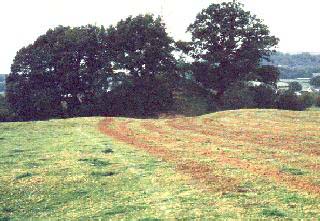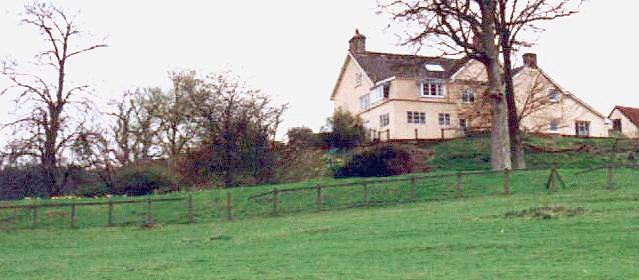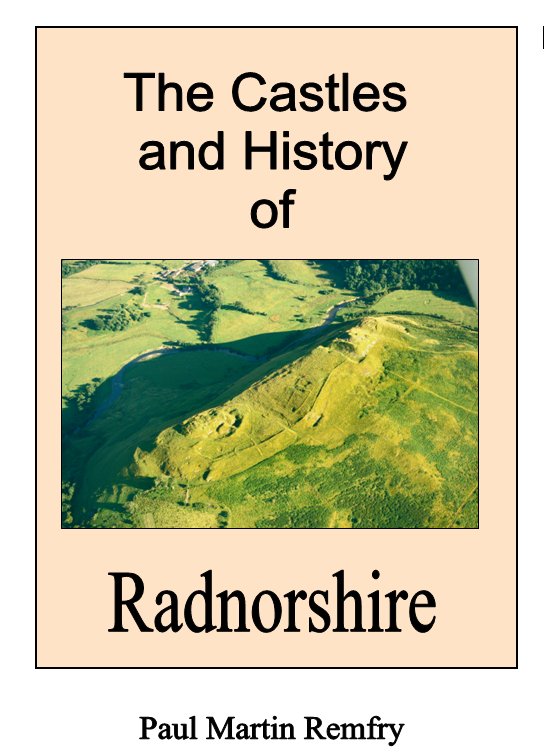Colwyn Castles
 Glan Edw, or the
first Colwyn Castle, is the only
motte and bailey in Elfael Uwch Mynydd commote. For this reason it is
almost
certainly the first castle called Colwyn. It was probably commenced in
1093 by Ralph Tosny of
Clifford and taken by the forces of Madog ab Idnerth around
1135 and then
rebuilt by Hugh Mortimer of
Wigmore in 1144. It was not mentioned again and must
have reverted to Welsh control probably with the defeat of Hugh by his
Angevin
enemies in the period 1148-53.
Old Colwyn castle was
subsequently rebuilt by the forces of
William
Braose of Radnor in 1195 and besieged and finally destroyed by Prince
Rhys ap Gruffydd in 1196. As a consequence of this, it
would seem unlikely
that the castle now known as Colwyn was actually founded much before
1196 when
its predecessor was abandoned.
Glan Edw, or the
first Colwyn Castle, is the only
motte and bailey in Elfael Uwch Mynydd commote. For this reason it is
almost
certainly the first castle called Colwyn. It was probably commenced in
1093 by Ralph Tosny of
Clifford and taken by the forces of Madog ab Idnerth around
1135 and then
rebuilt by Hugh Mortimer of
Wigmore in 1144. It was not mentioned again and must
have reverted to Welsh control probably with the defeat of Hugh by his
Angevin
enemies in the period 1148-53.
Old Colwyn castle was
subsequently rebuilt by the forces of
William
Braose of Radnor in 1195 and besieged and finally destroyed by Prince
Rhys ap Gruffydd in 1196. As a consequence of this, it
would seem unlikely
that the castle now known as Colwyn was actually founded much before
1196 when
its predecessor was abandoned.
The new
fortress was probably begun around 1200 when
William Braose was granted rights of conquest in this district and was
consequently probably seized from him on his rebellion
in
1208. On his sons'
subsequent rebellion in 1215 Colwyn was one of King John's castles
which were
left for Gwallter ab Einion Clud to take on behalf of his Braose
allies. The
castle seems to have remained in Welsh hands throughout the rule of
Llywelyn
ab Iorwerth, the truce brokers from England and Wales meeting there to
discuss the state of the borders in 1232. On Llywelyn's death the local
princes
seem to have managed to transfer their allegiance easily to that of King
Henry III
and to have remained in possession of the castle site.

Above: Colwyn showing the ringwork with farmhouse on it from the east
The Welsh
lords of Elfael paid their homage to King Henry on 3 February
1241. It is quite possible at this time that the castle was regarded as
an
appurtenance of Builth Wells
which was granted to Llywelyn by its Braose lord in
1229. The cantref of Buellt had been seized by Henry III in 1240 and
the castle
there refortified by John Monmouth. In 1248 Sir Owain ap Maredudd ab
Einion
Clud was recorded as holding all Elfael Uwch Mynydd, and therefore by
implication Colwyn castle, when it was unsuccessfully claimed from him
by his
cousin Roger Vaughan ab Gwallter Clud. In July 1260 Sir Owain, by then
a
sub-tenant of Roger Mortimer, surrendered to Prince Llywelyn after the
fall of
Builth Wells castle. Sir Owain seems to have weathered the following
storms and
in 1276/7 successfully returned to royal allegiance with the support of
his
many, now fully grown, sons. In December 1282, however, the old Sir
Owain and
his sons appear to have risen in favour of Prince
Llywelyn ap Gruffydd, immediately before his death on 11
December
1282. As a
consequence of their rebellion they lost Colwyn castle and the lands of
their
ancestors in Elfael. The castle was then taken, or possibly rebuilt by
Matilda
Mortimer (d.1303), the widow of Roger (d.1282). The fortress was
mentioned in
1309 and 1337, but seems to have been abandoned by 1397, when the
Beauchamps
were ruling Elfael from their base at Painscastle.
It is indicative of its abandoned state that no mention of its use
seems to have
been made during the Glyndwr
rebellion.
The Castles and History of
Radnorshire (ISBN 1-899376-82-8)
looks in great detail at both Glan Edw and Colwyn castle.
This book consists of 309 pages of A4 and
examines in greater detail the history and castles of Radnorshire and Rhwng Gwy a Hafren.
Starting in the early eleventh century the book covers the
age of the castles up to the Civil War of 1642-46.
Each castle description is buttressed by numerous photographs
and plans of the earthworks and remains where they survive. A
new look is also taken at the battlefield of Pilleth and the evidence
for the course of the battle is scrutinised. The book also
contains genealogical family trees of the major historical Radnorshire
families and a full index.
Available for £39.95.
For more
information on the Tosny family buy Clifford
Castle, 1066 to 1299
through the PayPal
basket below.
Copyright©1994-2007
Paul Martin Remfry
 Glan Edw, or the
first Colwyn Castle, is the only
motte and bailey in Elfael Uwch Mynydd commote. For this reason it is
almost
certainly the first castle called Colwyn. It was probably commenced in
1093 by Ralph Tosny of
Clifford and taken by the forces of Madog ab Idnerth around
1135 and then
rebuilt by Hugh Mortimer of
Wigmore in 1144. It was not mentioned again and must
have reverted to Welsh control probably with the defeat of Hugh by his
Angevin
enemies in the period 1148-53.
Old Colwyn castle was
subsequently rebuilt by the forces of
William
Braose of Radnor in 1195 and besieged and finally destroyed by Prince
Rhys ap Gruffydd in 1196. As a consequence of this, it
would seem unlikely
that the castle now known as Colwyn was actually founded much before
1196 when
its predecessor was abandoned.
Glan Edw, or the
first Colwyn Castle, is the only
motte and bailey in Elfael Uwch Mynydd commote. For this reason it is
almost
certainly the first castle called Colwyn. It was probably commenced in
1093 by Ralph Tosny of
Clifford and taken by the forces of Madog ab Idnerth around
1135 and then
rebuilt by Hugh Mortimer of
Wigmore in 1144. It was not mentioned again and must
have reverted to Welsh control probably with the defeat of Hugh by his
Angevin
enemies in the period 1148-53.
Old Colwyn castle was
subsequently rebuilt by the forces of
William
Braose of Radnor in 1195 and besieged and finally destroyed by Prince
Rhys ap Gruffydd in 1196. As a consequence of this, it
would seem unlikely
that the castle now known as Colwyn was actually founded much before
1196 when
its predecessor was abandoned.

